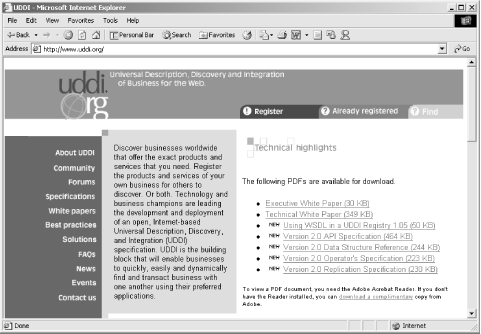UDDI
With no further suspense, I want to define what
UDDI is. It stands for
Universal Discovery, Description, and
Integration, and is most often associated with the word
“registry.” The primary place to learn about UDDI is its
web site, http://www.uddi.org
(shown in Figure 13-2), also the home of the UDDI
registry
that is so important in registering and locating services. This site
describes the UDDI project, which seeks to create and define a
complete framework for the exchange of data I’ve been talking
about in this chapter. The initiative is supported by both IBM and
Microsoft, so it looks like it’s around for the long haul.

Figure 13-2. The UDDI web site
The core of this is the network of services about which UDDI stores information. The ability to register a new service and search for an existing one is part and parcel of this registry, and is available online at the UDDI web site. All that is required is a simple registration process. Neither IBM nor Microsoft require a company or even an individual to pay high fees to make their services publicly available. Because of this, there are many, many more services being registered every day than a “for-profit” system would engender.
That’s all that there really is to UDDI. There is little complexity in the use of UDDI; the hard stuff is all in implementation, which you and I aren’t really interested as a service provider or consumer. ...
Get Java and XML, Second Edition now with the O’Reilly learning platform.
O’Reilly members experience books, live events, courses curated by job role, and more from O’Reilly and nearly 200 top publishers.

